The 5 main thoughts on shooting proper wedding photos!
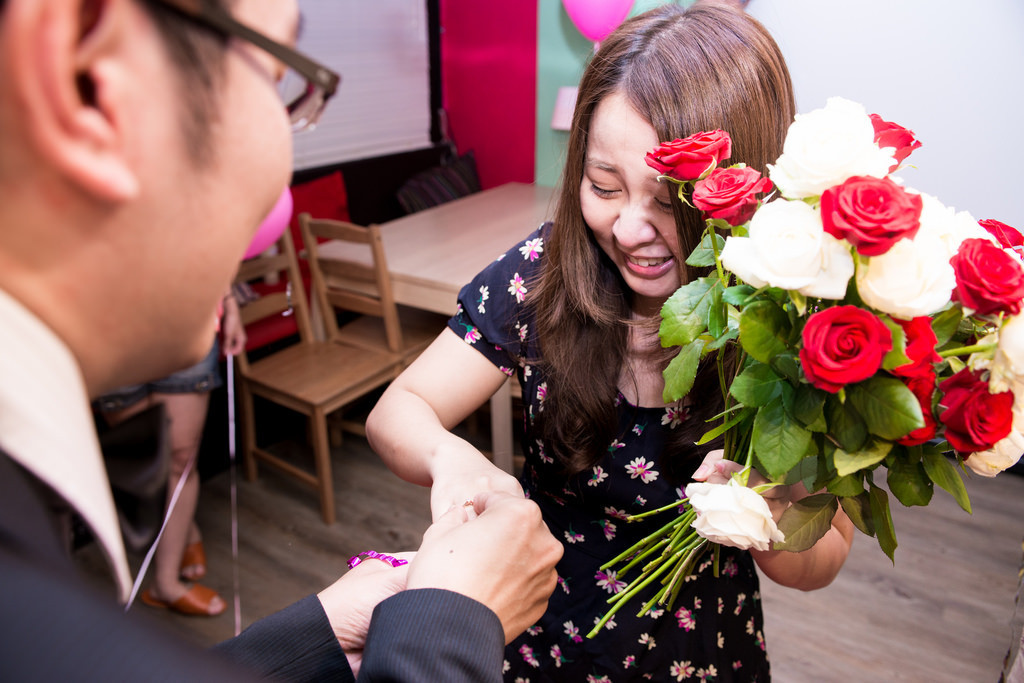
“My fellow photographers, you’ve probably more or less have had the experience of being invited to shoot some wedding photos. In the dimly lit banquet hall filled with friends and families moving about, how should one approach the feat of handling the entirety of the wedding procedure? Should you try and eternalize every precious, fleeting moment? This sure can cause a lot of stress! In this article, I will share five thoughts and suggestions on how to properly handle wedding photography, and hope that it will be of use to you.”
Have you ever been asked by a friend to photograph important life events? Whether it is a proposal or even a wedding ceremony, all of these are events that could potentially “cause a lifetime of regret if they are missed”. We won’t be chatting here why your friend would feel so “reassured” to place this responsibility onto you, we’ll just simply discuss: are you prepared to be the one to record another person’s important life event?
What I’m going to share with everyone here are some important things to note when photographing important events such as this, so this article would be more akin to a lesson on “photography senses”, and not photography skills. Because in my perspective, concepts and senses are more important in event photography compared to skills and techniques. After all, techniques could be compensated by using the automatic mode of the camera, but if your senses are off, and can’t get the best spots to capture the right scenes, then no matter how good you are at using a camera you’re really just “playing around” in the end. If you’re not able to capture the important moments, then prepare for a lifetime of complaints from your friend!
And as usual, I will save the ramblings and jump right into the tutorial.
1. Getting familiar with the procedure is more crucial than anything
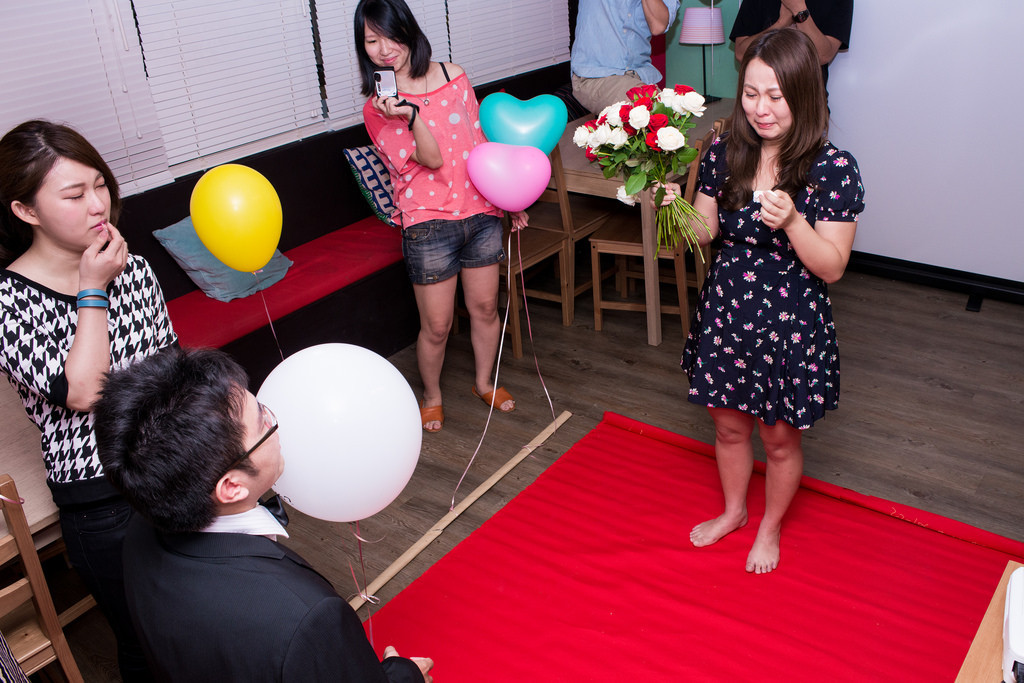 What is the most important part of photographing weddings and proposals? The answer is all the moments of moving emotions, I don’t suppose anyone would really care how beautiful you shoot the wedding dress or the wedding ring, but if you didn’t capture the kneeling moment, or the instant the rings are exchanged, then it’s pretty much over for you. Therefore be sure to remember, once you’ve accepted a job as important as this, do make sure to know in detail the whole procedure of the event: what will be happening when, where would you be doing what, and for how long, who needs to be in the shots are all important things manage. Or else by the time you realized that the proposal is reaching its climax when you’re still uncertain about the situation… things might just fall apart.
What is the most important part of photographing weddings and proposals? The answer is all the moments of moving emotions, I don’t suppose anyone would really care how beautiful you shoot the wedding dress or the wedding ring, but if you didn’t capture the kneeling moment, or the instant the rings are exchanged, then it’s pretty much over for you. Therefore be sure to remember, once you’ve accepted a job as important as this, do make sure to know in detail the whole procedure of the event: what will be happening when, where would you be doing what, and for how long, who needs to be in the shots are all important things manage. Or else by the time you realized that the proposal is reaching its climax when you’re still uncertain about the situation… things might just fall apart.
2. Claiming spots are definitely necessary, don’t feel sorry about it, be straightforward about which spots you will need!
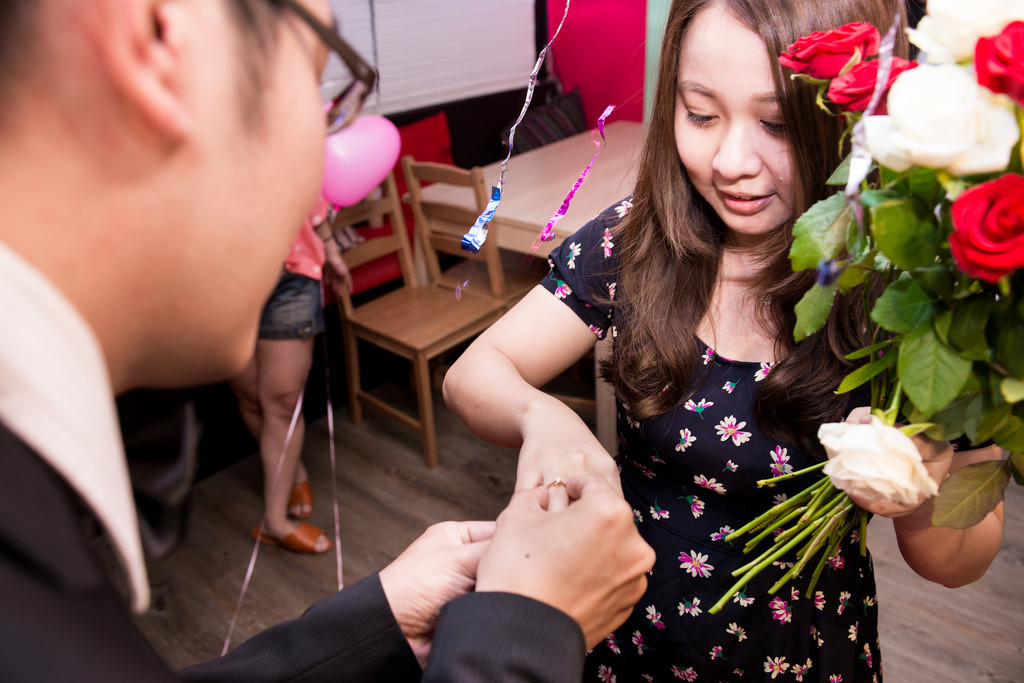 What’s the most difficult part to shoot during a proposal? Personally, I think it is the moment the rings are exchanged. Why? Because the rings are small, and the couple is usually standing very close to each other, therefore it is very difficult to capture the moment where the rings are exchanged. Usually, there aren’t many angles that will allow you to capture that moment, and most of the time you will be fighting over spots with people standing close by. So it is essential that you’re clear with where these important moments will be happening, and when you’re figuring out the procedure beforehand, place a chair or a ladder at the spot to claim it, so no one will be fighting over the spot with you during the shot. Remember, what you will be capturing is eternal, while the people standing by will but experience a momentary stir of emotion. Therefore do not hesitate to make requests, which spots should be reserved for you to shoot from, do make sure to mark them! No one is going to blame you. (Unless it is another photographer...)
What’s the most difficult part to shoot during a proposal? Personally, I think it is the moment the rings are exchanged. Why? Because the rings are small, and the couple is usually standing very close to each other, therefore it is very difficult to capture the moment where the rings are exchanged. Usually, there aren’t many angles that will allow you to capture that moment, and most of the time you will be fighting over spots with people standing close by. So it is essential that you’re clear with where these important moments will be happening, and when you’re figuring out the procedure beforehand, place a chair or a ladder at the spot to claim it, so no one will be fighting over the spot with you during the shot. Remember, what you will be capturing is eternal, while the people standing by will but experience a momentary stir of emotion. Therefore do not hesitate to make requests, which spots should be reserved for you to shoot from, do make sure to mark them! No one is going to blame you. (Unless it is another photographer...)
3. Engage the spirit of a reporter, don’t fear your poses being made fun of, and don’t fear “claiming unusual spots”
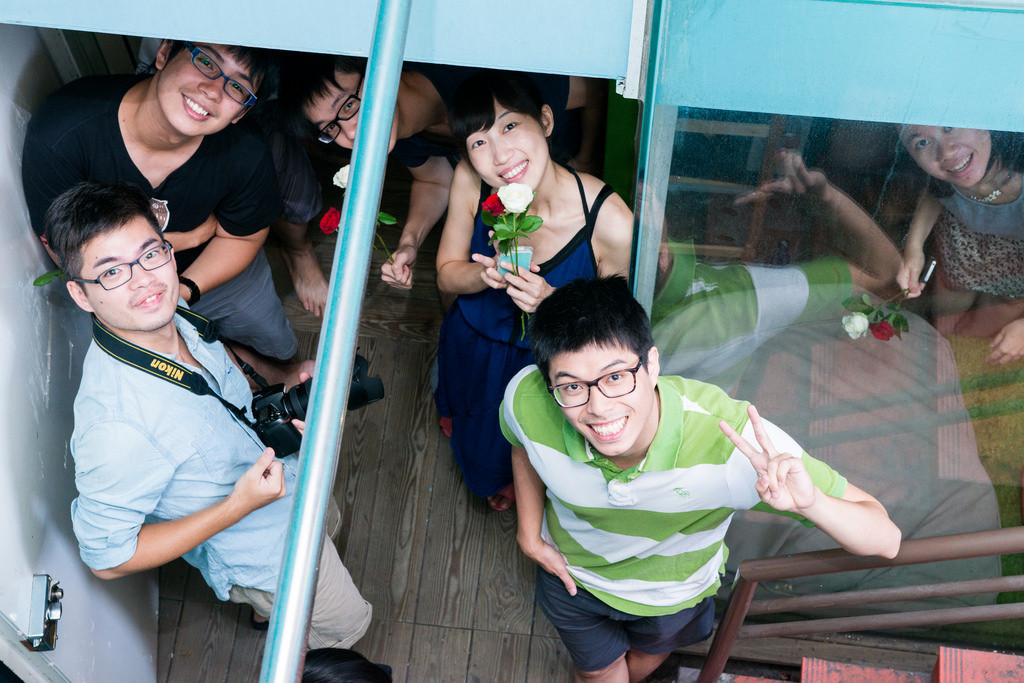 Making the most out of the location can allow you to capture interesting shots that are worth commemorating. For instance, the above photo is a shot of the basement from the flower stand above it, this is what I mean by not fearing unusual spots, don’t forfeit a nice spot for a photo just because you think that “a person shouldn’t be standing there”. Please do you best to find spots where you can capture heartfelt moments, under the premise of staying safe yourself, this is how you can capture shots from angles everyone else can’t. Or else if your shots look exactly the same as everyone else’s taken with a phone, what do people need you as a photographer for?
Making the most out of the location can allow you to capture interesting shots that are worth commemorating. For instance, the above photo is a shot of the basement from the flower stand above it, this is what I mean by not fearing unusual spots, don’t forfeit a nice spot for a photo just because you think that “a person shouldn’t be standing there”. Please do you best to find spots where you can capture heartfelt moments, under the premise of staying safe yourself, this is how you can capture shots from angles everyone else can’t. Or else if your shots look exactly the same as everyone else’s taken with a phone, what do people need you as a photographer for?
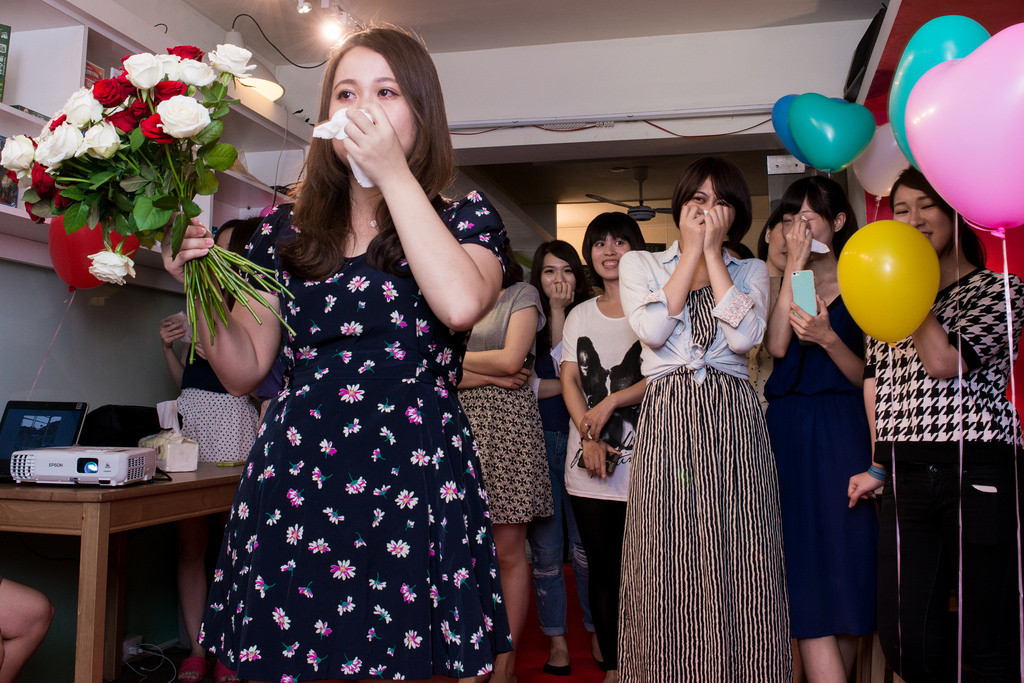 Image above: Lying on the ground for a shot is definitely not shameful, the real shame is to miss the perfect shot by caring too much about your poses
Please repeat after me, “photographers have the right to lie on the floor”! No matter how ridiculous your poses look, as long as you get the shots, it is worth it even if you have to lie on the floor. I’ve witnessed many friends miss the perfect moment for a shot due to concerns over their poses. Therefore do not even think that your poses might be ridiculous, you are doing the noble work of “recording history” if anyone wants to laugh at your poses, just let them! Only by not caring about the things that do not matter, will you be able to increase your chances of capturing moments of genuine emotion?
But please do not forget that safety should always come first, it would be disastrous if you fall into the ocean just to get a shot! (A while back a Taiwanese photographer did fall into the sea when trying to capture a shot, so be careful when shooting!)
Image above: Lying on the ground for a shot is definitely not shameful, the real shame is to miss the perfect shot by caring too much about your poses
Please repeat after me, “photographers have the right to lie on the floor”! No matter how ridiculous your poses look, as long as you get the shots, it is worth it even if you have to lie on the floor. I’ve witnessed many friends miss the perfect moment for a shot due to concerns over their poses. Therefore do not even think that your poses might be ridiculous, you are doing the noble work of “recording history” if anyone wants to laugh at your poses, just let them! Only by not caring about the things that do not matter, will you be able to increase your chances of capturing moments of genuine emotion?
But please do not forget that safety should always come first, it would be disastrous if you fall into the ocean just to get a shot! (A while back a Taiwanese photographer did fall into the sea when trying to capture a shot, so be careful when shooting!)
4. Site surveying and light testing are absolutely necessary! Do not give into laziness.
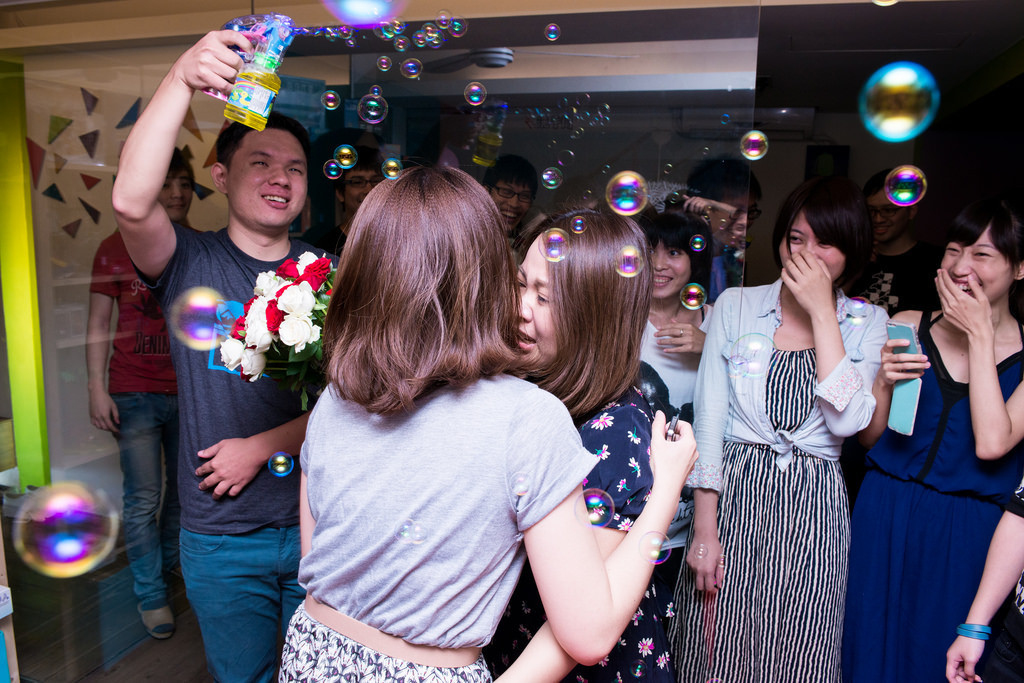 No matter how much space you have, large ceremonies such as proposals or marriages that would be flooded with people will sure cause you problems when trying to navigate the area. While it’s fine for everyone else, if you join in on the chaos, you’ll miss the best chances to take your photos! So make sure to understand the traffic flow of the event site, and devise a few plans beforehand on how you can get to the front of the crowd. Or else by the time you’re done with the crowd, the main event ahead would be over already, and you might as well give up on taking pictures.
No matter how much space you have, large ceremonies such as proposals or marriages that would be flooded with people will sure cause you problems when trying to navigate the area. While it’s fine for everyone else, if you join in on the chaos, you’ll miss the best chances to take your photos! So make sure to understand the traffic flow of the event site, and devise a few plans beforehand on how you can get to the front of the crowd. Or else by the time you’re done with the crowd, the main event ahead would be over already, and you might as well give up on taking pictures.
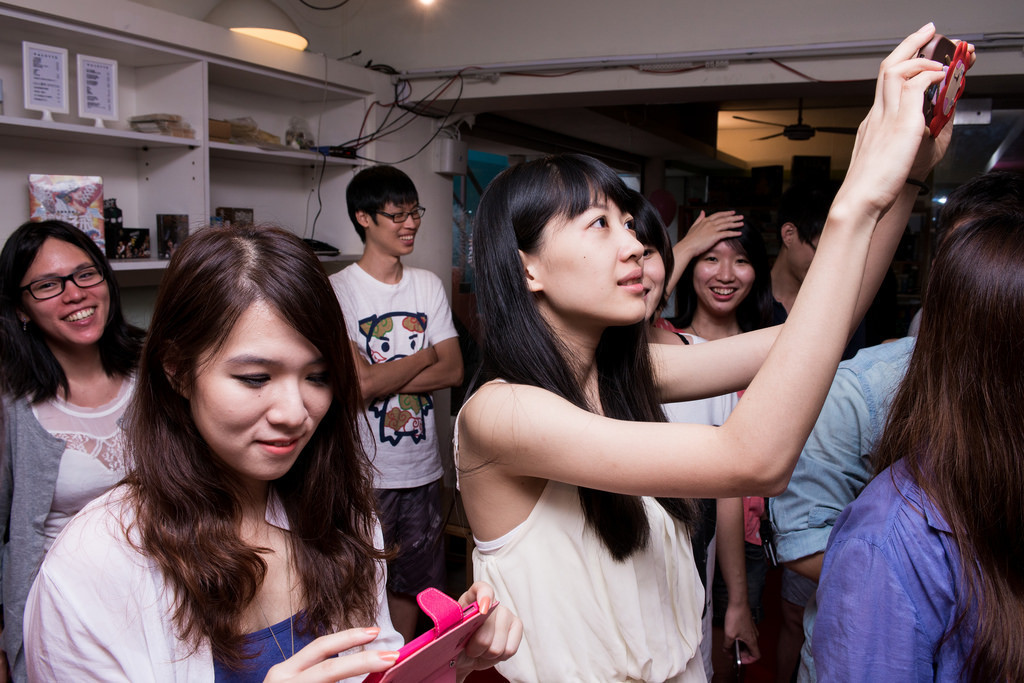 Testing the lighting of the location is absolutely necessary! Because even in the same location, depending on where you’ll be standing, there may still be troubles with the lighting. Take for instance bounce flashing, if you just so happen to stand under a crossbeam, the person that you’re trying to shoot in front of you won’t be able to receive the fill-in flash(the light gets blocked by the beam). You can see in the picture above that everything behind the beam on the top right is dark, that is because the light from the flash is blocked by it. So in order to prevent these mistakes, it’s best to get a good idea of what the location is like so you can prevent standing in the wrong spots that result in taking incorrectly exposed photos.
Testing the lighting of the location is absolutely necessary! Because even in the same location, depending on where you’ll be standing, there may still be troubles with the lighting. Take for instance bounce flashing, if you just so happen to stand under a crossbeam, the person that you’re trying to shoot in front of you won’t be able to receive the fill-in flash(the light gets blocked by the beam). You can see in the picture above that everything behind the beam on the top right is dark, that is because the light from the flash is blocked by it. So in order to prevent these mistakes, it’s best to get a good idea of what the location is like so you can prevent standing in the wrong spots that result in taking incorrectly exposed photos.
5. Remember to decrease the aperture when taking group photos, and ask people to “not be in a hurry to leave”
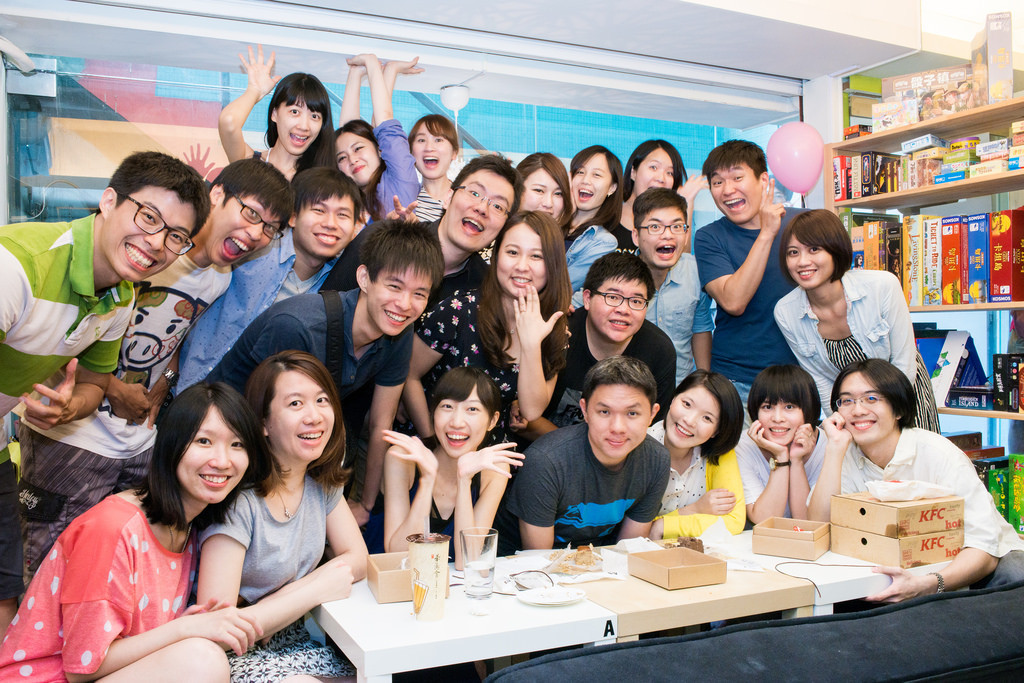 A lot of people often forget to do one thing when shooting with a single-lens reflex camera: decrease the aperture. Why does the aperture need to be decreased? If you remember the thing I shared before about the effects of aperture settings, you would know that if the aperture is too large, the depth of field will be shallow, which will result in everyone else besides the person that you’re focusing on being blurred. Especially in pictures like this one above where the people are layered, there’s a high chance that the front row happens will be in focus while the back rows aren’t. Therefore I suggest setting the aperture above f14, to prevent the stated problem from happening. Furthermore, since using a smaller aperture requires a longer exposure time, make sure to remind everyone to wait until the second after the shutter is pressed before leaving, or else there will be blurry shadows of people who were trying to leave early!
These are the basic things you must note when doing photo shoots for such type of events, although this is not an assurance that every shot you take will be unforgettable, it can at least provide you with an idea of how to lower your chances of failure. Additionally, if your interest is to photograph events or people, then these are all things that you should remember and internalize for future application. As for which camera and lens you should use? That would be simple unless your friend is getting married in an exceptionally large event hall, a zoom lens with the focal length between 24-70 would do, there would be no need for telephoto lenses. If you find that the zoom just isn’t enough no matter what, then refer to the third and fourth points of this lesson, and reevaluate why the spot you picked isn’t close enough to the scene!
If you are interested in our articles, you can also LIKE our page:)
A lot of people often forget to do one thing when shooting with a single-lens reflex camera: decrease the aperture. Why does the aperture need to be decreased? If you remember the thing I shared before about the effects of aperture settings, you would know that if the aperture is too large, the depth of field will be shallow, which will result in everyone else besides the person that you’re focusing on being blurred. Especially in pictures like this one above where the people are layered, there’s a high chance that the front row happens will be in focus while the back rows aren’t. Therefore I suggest setting the aperture above f14, to prevent the stated problem from happening. Furthermore, since using a smaller aperture requires a longer exposure time, make sure to remind everyone to wait until the second after the shutter is pressed before leaving, or else there will be blurry shadows of people who were trying to leave early!
These are the basic things you must note when doing photo shoots for such type of events, although this is not an assurance that every shot you take will be unforgettable, it can at least provide you with an idea of how to lower your chances of failure. Additionally, if your interest is to photograph events or people, then these are all things that you should remember and internalize for future application. As for which camera and lens you should use? That would be simple unless your friend is getting married in an exceptionally large event hall, a zoom lens with the focal length between 24-70 would do, there would be no need for telephoto lenses. If you find that the zoom just isn’t enough no matter what, then refer to the third and fourth points of this lesson, and reevaluate why the spot you picked isn’t close enough to the scene!
If you are interested in our articles, you can also LIKE our page:)
相關文章
-
Dedicated to new photography fans, three key methods for the operation of Speedlights
-
Methods on shooting in the interior of a car
-
Methods on shooting interior lighting
-
The lighting for food is important? Let Tastemade tell you!
-
Know before buying a camera: teaching you to know what is the sensor size, focal length, aperture?
-
Can’t have the best of both worlds? Lesson on how to shoot clear night + portrait photography!
